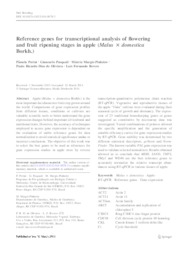Reference genes for transcriptional analysis of flowering and fruit ripening stages in apple (Malus 3 domestica Borkh.).
Reference genes for transcriptional analysis of flowering and fruit ripening stages in apple (Malus 3 domestica Borkh.).
Author(s): PERINI, P.; PASQUALI, G.; MARGIS-PINHEIRO, M.; OLIVEIRA, P. R. D. de; REVERS, L. F.
Summary: Apple (Malus 9 domestica Borkh.) is the most important deciduous tree fruit crop grown around the world. Comparisons of gene expression profiles from different tissues, conditions or cultivars are valuable scientific tools to better understand the gene expression changes behind important silvicultural and nutritional traits. However, the accuracy of techniques employed to access gene expression is dependent on the evaluation of stable reference genes for data normalization to avoid statistical significance undue or incorrect conclusions. The objective of this work was to select the best genes to be used as references for gene expression studies in apple trees by reverse transcription-quantitative polymerase chain reaction (RT-qPCR). Vegetative and reproductive tissues of the apple ??Gala?? cultivar were evaluated during their seasonal cycle of growth and dormancy. The expression of 23 traditional housekeeping genes or genes suggested as constitutive by microarray data was investigated. Tested combinations of primers allowed the specific amplification and the generation of suitable efficiency curves for gene expression studies by RT-qPCR. Gene stability was determined by two different statistical descriptors, geNorm and Norm-Finder. The known variable PAL gene expression was used to validate selected normalizers. Results obtained allowed us to conclude that MDH, SAND, THFS, TMp1 and WD40 are the best reference genes to accurately normalize the relative transcript abundances using RT-qPCR in various tissues of apple.
Publication year: 2014
Types of publication: Journal article
Unit: Embrapa Grape & Wine
Keywords: Expressão genética, Gala, Genes de referencia, Genetica vegetal, Maçã, RT-qPCR
Observation
Some of Embrapa's publications are published as ePub files. To read them, use or download one of the following free software options to your computer or mobile device. Android: Google Play Books; IOS: iBooks; Windows and Linux: Calibre.
Access other publications
Access the Agricultural Research Database (BDPA) to consult Embrapa's full library collection and records.
Visit Embrapa Bookstore to purchase books and other publications sold by Embrapa.

